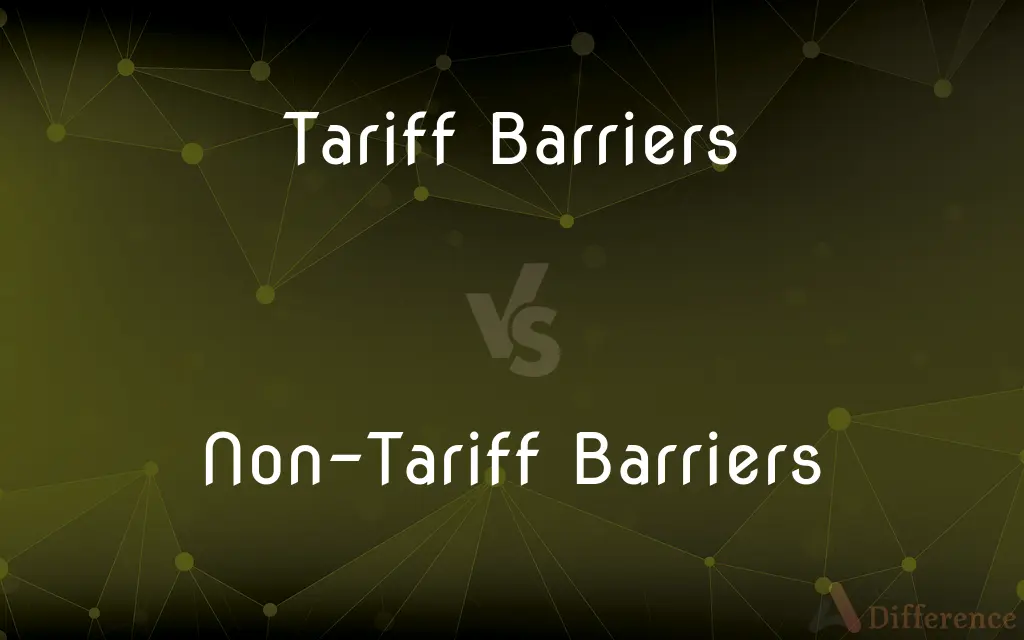Tariff Barriers vs. Non-Tariff Barriers — What's the Difference?
Edited by Tayyaba Rehman — By Fiza Rafique — Published on December 10, 2023
Tariff Barriers involve taxes on imports or exports, while Non-Tariff Barriers are trade restrictions without tax imposition.

Difference Between Tariff Barriers and Non-Tariff Barriers
Table of Contents
ADVERTISEMENT
Key Differences
Tariff Barriers are primarily taxes or duties imposed on imported or exported goods. By increasing the cost of imported goods through tariffs, a country can make domestic products more competitive. This generates revenue for the government and can protect domestic industries from foreign competition.
Non-Tariff Barriers, conversely, encompass a wide range of policy measures other than tariffs that can deter international trade. This includes quotas, licensing requirements, or standards and regulations that can disproportionately affect imported goods. These barriers can be used to control the quantity of goods coming into a country, as opposed to just influencing their price as tariff barriers do.
Tariff Barriers have a direct financial implication. For example, if a country places a 10% tariff on imported electronics, an electronic item worth $100 would cost $110 to import. This approach is transparent, and its impact on trade can be quantified with relative ease.
Non-Tariff Barriers can be more opaque. For instance, stringent product standards or complicated customs procedures can act as significant deterrents to trade, even if there's no associated tax. The impact of these barriers can be more challenging to quantify and may be perceived as arbitrary or protectionist in nature.
Finally, while Tariff Barriers are clear in their intent to either generate revenue or protect domestic industries, Non-Tariff Barriers can sometimes be justified on other grounds, like public health, safety, or environmental protection, even if they do restrict trade.
ADVERTISEMENT
Comparison Chart
Part of Speech
Noun (Plural)
Noun (Plural)
Use in Compound Sentences
"While the country relied on Tariff Barriers to shield its industries, it also utilized Non-Tariff Barriers to manage trade volumes."
As mentioned earlier
Dependent Prepositions
"With Tariff Barriers"
"Through Non-Tariff Barriers"
Common Adjectives Describing Them
"Tax-based, financial"
"Regulatory, restrictive"
Impact on Trade
Direct financial impact
Can have varied impacts, often non-financial
Compare with Definitions
Tariff Barriers
Government revenue sources derived from international commerce.
The country's reliance on Tariff Barriers meant significant income from import duties.
Non-Tariff Barriers
Limits on trade volumes, such as quotas.
The nation set import quotas on textiles, creating Non-Tariff Barriers for foreign producers.
Tariff Barriers
Monetary barriers affecting international market competition.
High Tariff Barriers discouraged foreign competitors from entering the local market.
Non-Tariff Barriers
Barriers to trade that do not involve direct financial costs.
The import licensing requirements were among the Non-Tariff Barriers challenging businesses.
Tariff Barriers
Taxes imposed on imported or exported goods.
The country increased its Tariff Barriers on luxury cars to protect domestic manufacturers.
Non-Tariff Barriers
Regulatory or procedural hurdles in international commerce.
Complicated customs documentation served as Non-Tariff Barriers, slowing down trade.
Tariff Barriers
Financial duties used to regulate international trade.
By leveraging Tariff Barriers, the government aimed to boost local agricultural production.
Non-Tariff Barriers
Trade restrictions not based on price or tax.
The mandatory product testing was one of the key Non-Tariff Barriers impeding imports.
Tariff Barriers
Price-based impediments affecting the movement of goods across borders.
Trade negotiations focused on reducing Tariff Barriers to enhance bilateral trade.
Non-Tariff Barriers
Standards or certifications affecting the entry of goods.
Strict health standards for meat and poultry acted as Non-Tariff Barriers.
Common Curiosities
How do Non-Tariff Barriers differ?
They represent trade restrictions not based on tax or price.
Do Tariff Barriers always deter trade?
Not always, but they can make imported goods more expensive and less competitive.
What are Tariff Barriers?
They are taxes or duties imposed on imported or exported goods.
Do Tariff Barriers generate revenue for governments?
Yes, they provide income from import and export duties.
Are Tariff Barriers easily quantifiable?
Yes, they have a direct financial implication and are transparent.
Can Tariff Barriers protect domestic jobs?
Potentially, by making foreign goods more expensive and domestic goods more competitive.
Are all Non-Tariff Barriers intentional trade restrictions?
Not always; some might arise from bureaucratic inefficiencies or genuine safety concerns.
Why might a country use Non-Tariff Barriers?
To control trade quantities, protect industries, or address health and safety concerns.
Do Tariff Barriers affect both imports and exports?
Primarily imports, but they can be applied to exports too.
Can Non-Tariff Barriers be seen as protectionist?
Often, though they can also be justified on other grounds like health or safety.
What's an example of a Non-Tariff Barrier?
Import quotas or stringent product standards.
Can Non-Tariff Barriers affect the quality of products?
Yes, especially if they involve product standards or certifications.
Are Tariff Barriers a form of trade policy?
Yes, they are a key instrument in trade policy.
Between Tariff Barriers and Non-Tariff Barriers, which is more transparent?
Tariff Barriers are more transparent due to their direct financial nature.
Do Non-Tariff Barriers always deter trade?
They can, especially if they are overly restrictive or arbitrary.
Share Your Discovery

Previous Comparison
iTunes vs. Apple Music
Next Comparison
MBO vs. MBEAuthor Spotlight
Written by
Fiza RafiqueFiza Rafique is a skilled content writer at AskDifference.com, where she meticulously refines and enhances written pieces. Drawing from her vast editorial expertise, Fiza ensures clarity, accuracy, and precision in every article. Passionate about language, she continually seeks to elevate the quality of content for readers worldwide.
Edited by
Tayyaba RehmanTayyaba Rehman is a distinguished writer, currently serving as a primary contributor to askdifference.com. As a researcher in semantics and etymology, Tayyaba's passion for the complexity of languages and their distinctions has found a perfect home on the platform. Tayyaba delves into the intricacies of language, distinguishing between commonly confused words and phrases, thereby providing clarity for readers worldwide.
















































